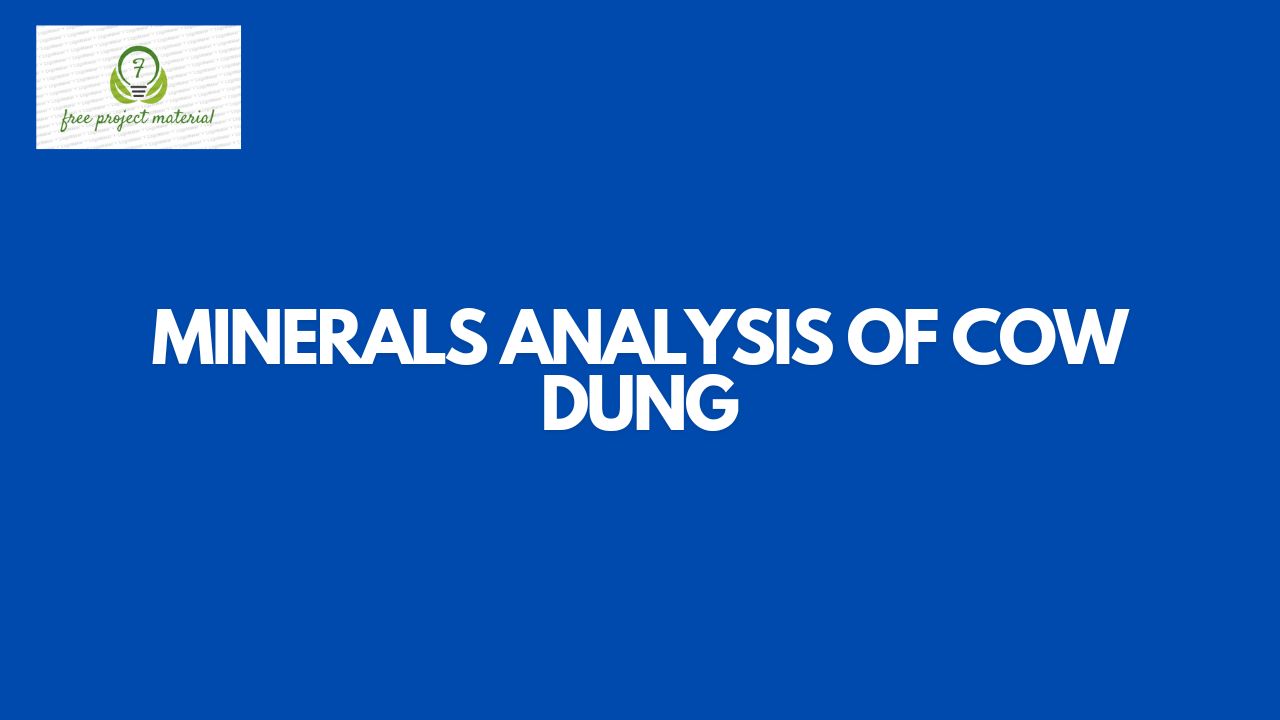ABSTRACT
This study on mineral analysis of cow dung was carried out using standard analytical method. The result of the study revealed the following: Potassium (13.40 mg/kg), Magnesium (18.41 mg/kg), Sodium (21.21 mg/kg), Copper (8.40 mg/kg), Phosphorus (11.43 mg/kg), Calcium (12.14 mg/kg). The result shows that cow dung manure is rich in nutrients and is suitable for plant growth. Therefore, Cow dung should be used in improving soil fertility
TABLE OF CONTENTS
Title Page – – – – – – – – i
Certification – – – – – – – ii
Dedication – – – – – – – – iii
Acknowledgements – – – – – – iv
Abstract – – – – – – – – v
Table of Contents – – – – – – – vi
CHAPTER ONE: INTRODUCTION
1.1 Background of the Study – – – – – – 1
1.2 Aim and Objectives of the Study – – – – 3
1.3 Scope and Limitation of the Study – – – – 3
CHAPTER TWO: LITERATURE REVIEW
2.1 Cow dung – – – – – – – – 4
2.2 Application of Cow dung – – – – – – 4
2.2.1 Source of Energy – – – – – – – 4
2.2.2 As Fertilizer – – – – – – – – 7
2.2.3 Agriculture Management – – – – – – 8
2.2.4 Bioremediation of Environment Pollutants – – – 10
2.2.5 Source of Microbial Enzymes – – – – – 12
2.2.6 Human Health Management – – – – – 14
2.3 Macronutrient and its Role in Plant – – – – 17
2.4 Micronutrients and its Role in Plant – – – – 19
CHAPTER THREE: MATERIALS AND METHOD
3.1 Materials – – – – – – – – 22
3.2 Methods – – – – – – – – 22
3.2.1 Sample Collection – – – – – – – 22
3.2.2 Preparation of Sample – – – – – 22
3.3 Mineral Analysis – – – – – – – 23
CHAPTER FOUR: RESULTS AND DISCUSSION
4.1 Results – – – – – – – – 24
4.2 Discussion – – – – – – – – 25
CHAPTER FIVE: CONCLUSION AND RECOMMENDATIONS
5.1 Conclusion – – – – – – – – 27
5.2 Recommendations – – – – – – – 27
References
CHAPTER ONE: INTRODUCTION
1.1 Background of the Study
Cow dung can be defined as the undigested residue of consumed food material being excreted by herbivorous bovine animal species. Being a mixture of faeces and urine in the ratio of 3:1, it mainly consists of lignin, cellulose and hemicelluloses. It also contains 24 different minerals like nitrogen, potassium, along with trace amount of sulphur, iron, magnesium, copper, cobalt and manganese. The indigenous Indian cow also contain higher amount of calcium, phosphorus, zinc and copper than the cross-breed cow (Garg and Mudgal 2007; Randhawa and Kullar 2011). Cow dung harbours a rich microbial diversity, containing different species of bacteria (Bacillus spp., Corynebacterium spp. and Lactobacillus spp.), protozoa and yeast (Saccharomyces and Candida) (Nene, 1999; Randhawa and Kullar, 2011).
The world is facing a various concerning problems to get significant food in a sustainable manner, fulfilling the requirements of an increasing world population because of decreasing food resources (Rehman et al., 2020a). Many countries are facing the problems nutrients deficiency (Saeed et al., 2020). Growth of plants influenced by a number of factors including water availability, temperature, availability of nutrients and light in the soil. The growth of the plant is also dependent upon the microbes including plant growth promoting rhizobacteria that are involved directly by fixing the atmospheric nitrogen, solubilization of insoluble phosphate and secretions of hormones including IAA, kinetics and GAs (Rehman et al., 2020). Justus von Liebig, a German scientist, was one of the first scientists who illustrated that the nutrients are vital for the growth of plant. According to researches, there are above 100 chemical elements but study has determined almost 17 nutrients that are also called essential nutrients (Jones and Jacobsen, 2005). For the growth and development of plants these nutrients are vital (Kalsoom et al., 2020). Out of the 17 necessary elements, some are the non-mineral nutrients like carbon (C), hydrogen (H) and oxygen (O) because they are derivative from the water and air. The remaining are 14 essential nutrients that comprise of 6 macronutrients: nitrogen (N), phosphorus (P), potassium (K), calcium (Ca), magnesium (Mg) (Adnan et al., 2020a; Adnan et al., 2021), and sulphur (S); and 8 micronutrients: boron (B), chlorine (Cl), copper (Cu), iron (Fe), manganese (Mn), molybdenum (Mo), nickel (Ni) and zinc (Zn) (Brady and Weil, 2008).
1.2 Aim and Objective of the Study
The aim of this study is on estimation of mineral content of cow dung.
The objective of this research are;
- To investigate the Na and K content of cow dung.
- To compare the result of this study with previous studies
- To make useful recommendation base on the result of this study
1.3 Scope and Limitation of the Study
The scope of this study is only estimate the minerals content of cow dung. This is due to time and financial constraint.


